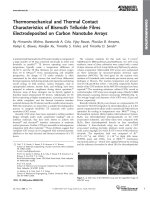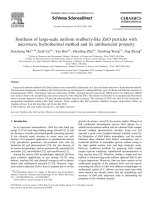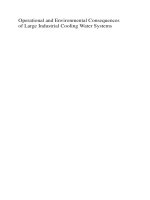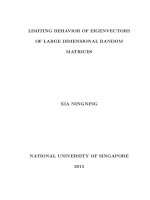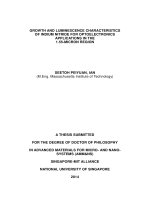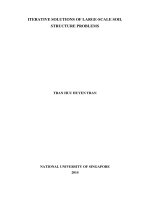Fresh semen characteristics of large white yorkshire boar semen selected for liquid semen preservation
Bạn đang xem bản rút gọn của tài liệu. Xem và tải ngay bản đầy đủ của tài liệu tại đây (203.21 KB, 7 trang )
Int.J.Curr.Microbiol.App.Sci (2019) 8(9): 1584-1590
International Journal of Current Microbiology and Applied Sciences
ISSN: 2319-7706 Volume 8 Number 09 (2019)
Journal homepage:
Original Research Article
/>
Fresh Semen Characteristics of Large white Yorkshire Boar Semen
Selected for Liquid Semen Preservation
T. Shylesh1*, Hiron M. Harshan1, Megha Wilson2, K. Promod1,
A. P. Usha3, C. Sunanda4 and M. P. Unnikrishnan4
1
Department of Animal Reproduction, Gynaecology and Obstetrics, CVAS, Pookode, India
2
Poultry Division, Brahmagiri Development Society, Sultanbathery, India
3
Centre for Pig Production and Research, Mannuthy, India
4
Department of Statistics, CVAS, Pookode, India
*Corresponding author
ABSTRACT
Keywords
Progressive
Motility, Viability,
Abnormality,
Acrosome integrity,
HOST
Article Info
Accepted:
18 August 2019
Available Online:
10 September 2019
The laboratory examination of semen quality parameters is an indirect way of
assessing male fertility. The objective of this research was to study the semen
quality parameters of Large White Yorkshire (LWY) boar ejaculates, which
had the minimum sperm progressive motility necessary for being selected for
further processing. The pigs were maintained at the Centre for pig production
and research, Mannuthy, Kerala. A total of 24 ejaculates were collected from
seven boars using gloved hand technique. The collected semen was examined
for volume, colour, pH, sperm concentration, progressive motility, viability,
abnormality, acrosome integrity and functional membrane integrity. Gel free
volume differed significantly between boars. There was no significant
difference observed in pH, sperm concentration and progressive motility
among the seven boars studied. Significantly higher (p<0.05) viable sperms
were observed in few boars. Similar observations were noted with respect to
sperm abnormality too. Significant differences (p<0.05) were observed in
acrosome integrity and hypo-osmotic sperm swelling response among boars.
Introduction
Pigs offer a great support to livestock farmers
due to their high prolificacy, feed conversion
efficiency, short generation interval and
smaller capital investment. For ensuring
revenue from the venture, the breeding
efficiency from the pigs has to be ensured.
Though artificial insemination (AI) in pig
industry plays a major role in upgradation of
species, it is not as popular as in cattle because
of limitations of semen quantity required for
1584
Int.J.Curr.Microbiol.App.Sci (2019) 8(9): 1584-1590
insemination
and
poor
preservability
(especially freezability) of boar semen. The
laboratory evaluation of semen quality
parameters is a convenient indirect way of
assessing male fertility, without conducting an
artificial insemination trial on each ejaculate.
Hence, the article describes the normal
parameters of LWY boar semen reared under
Kerala conditions.
Materials and Methods
Twenty four ejaculates from seven LWY
boars aged between 12-24 months, maintained
at the Centre for Pig Production and Research,
Mannuthy, were collected using gloved hand
technique and a dummy mount. The semen
was collected into a pre-warmed amber
coloured insulated conical flask after allowing
it to pass through a Buchner funnel to separate
the gel mass. The collected semen was
immediately transported to the laboratory for
preliminary evaluation in an insulated
container. The fresh semen collected was
evaluated
for
volume,
colour,
pH,
concentration, progressive motility, sperm
viability, sperm abnormality, acrosome
integrity and sperm response to hypo-osmotic
swelling test (HOST). The volume of the
semen ejaculate was measured by using
graduated class A glass cylinder of 250 mL
capacity. The colour of each ejaculate was
visually assessed and pH was measured using
hand held pH meter (Horiba, Model –
LAQUAtwin pH-11, USA). The sperm
concentration in the semen was evaluated by
haemocytometer method (Salisbury et al.,
1985). Sperm progressive motility was
recorded as a per cent of individual motility of
the spermatozoa after diluting the semen. Only
ejaculates with more than 70 per cent
progressive motility were selected for further
evaluation. Thus comparison was made
between ejaculates found suitable for liquid
semen preservation. Sperm viability and
abnormality was assessed using eosin-nigrosin
staining technique as described by Campbell
et al., (1953) sperm acrosome integrity by
Giemsa staining technique as described by
Watson (1975) and the functional membrane
integrity of the spermatozoa was assessed by
HOST response as per the method described
by Jeyendran et al., (1984).
Percentage data recorded were transformed
using Arcsine prior to analysis. Treatment
means were compared using one way Analysis
of variance (ANOVA).
Results and Discussion
The colour of the gel free ejaculates ranged
from milky to thick milky. Of the 24
ejaculates collected, two had thin milky
colour, seventeen had milky colour and five
had thick milky colour. The observations of
the current study were similar to the findings
of Sreekumaran (1974). Frunza et al., (2008)
reviewed that the normal colour for boar
semen ejaculate was white with bluish
shadows. A decrease in spermatozoa
concentration (even due to increased
frequency of collections) made the semen
colour to appear clear.
The volume of the semen ejaculates ranged
between 120-280 mL, with a mean volume of
197.33 ± 8.65 mL. The volume of semen was
significantly higher (p<0.01) in boar 1 and 3;
and significantly lower (p<0.01) in boar 5.
The observed gel free ejaculate volume was
similar to those observed by Kantharaj (2001)
in LWY (209.50 ± 4.63 mL). Hafez (1993)
recorded a range of 50-400 mL for semen
volume in boars. The semen volume observed
in the present study fell within these reported
ranges.
The overall average fresh semen pH was
found to be on the alkaline side (7.39 ± 0.03),
ranging from 7.10-7.60. On an individual boar
basis the pH was found to range from 7.30 ±
1585
Int.J.Curr.Microbiol.App.Sci (2019) 8(9): 1584-1590
0.09 to 7.50 ± 0.00. There was no significant
difference observed in the pH of semen
ejaculates between the boars. According to
Johnson et al., (2000), the pH of boar semen
ejaculate was in the range of 7.2-7.5, which
was in accordance to the findings in the
current work. The pH recorded by Strzezek et
al., (1995) in Yorkshire boar semen was
slightly lower (7.1 ± 0.07). Semen ejaculates
of the same animal can differ in its pH. A
higher contribution of accessory sex gland
secretions to the ejaculate, increased the
alkalinity of semen (Mann, 1974).
The overall sperm concentration ranged from
140 to 310.8 million/mL with a mean ± SE of
236.82 ± 9.49 million/mL. On an individual
boar basis the sperm concentration varied
from 166.67 ± 13.33 to 276.67 ± 12.02
million/mL. No significant variation was
observed among the sperm concentration
between the seven boars. This was in
accordance with the observations of
Labussiere (1990; 200-300 million/mL) and
Strzezek et al., (1995; 211 ± 22.07 million
sperms/mL) in Yorkshire boar semen.
Kantharaj (2001) recorded a sperm
concentration of 261-329 million/mL with an
average of 288.28 ± 2.73 million/mL in LWY
boar semen, which was slightly higher than
the concentration observed in the present
study. The sperm concentration in the semen
decreases as the frequency increases. With
increasing frequency, the ejaculate volume is
mainly contributed by seminal fluid from
accessory glands and there will be a reduction
in the concentration.
The overall sperm progressive motility,
immediately after collection, ranged from
75.00 – 85.00 per cent with an average of
79.38 ± 0.76 per cent. Individual boar
progressive motile sperm per cent varied from
75.00 ± 0.00 to 83.33 ± 1.67. No significant
difference was observed in progressive
motility of sperm in fresh semen between
boars, which was in agreement with the
findings of Kantharaj (2001). Much lower
values of 65.70 per cent were observed by
Sreekumaran (1974) with LWY boars.
Cerolini et al., (2001) recorded motility of
63.00 ± 2.20 per cent in a study which
included boars of different genetic lines
(Landrace, Large White and commercial
hybrids).
In current study, the mean ± SE sperm
viability in the fresh semen samples was found
to be 84.00 ± 0.83 with the range of 77–90 per
cent. Individual boar viable sperm per cent
varied from 79.00 ± 0.91 to 88.50 ± 1.26.
Significantly higher (p<0.05) viability was
found in boar 1 and significantly lower
(p<0.05) viability was found in boar 5. The
recorded values were found to be much closer
to values obtained in LWY boars by Murthy
(1974, 84.5 per cent) and slightly higher
values was reported by Sreekumaran (1974,
88.8 per cent) and Kantharaj (2001, 87.53 ±
0.56 per cent). The sperm viability observed
was also lower to those observed in
Hampshire boars (90.92 ± 1.56 per cent,
Kumaresan et al., 2009) and LWY boars
(92.40 ± 0.28 per cent, Lalrintluanga et al.,
2016). The observed differences could be due
to variations in season and handling of semen.
The overall mean ± SE sperm abnormality
recorded in the present study of fresh ejaculate
obtained from LWY boars was 6.15 ± 0.57 per
cent with a range of 2.00 –12.00 per cent. On
an individual boar basis the sperm abnormality
varied from 3.17 ± 0.44 to 9.50 ± 1.19 per
cent.
Significantly
higher
(p<0.05)
abnormality was found in boar 6 and
significantly lower (p<0.05) abnormality was
found in boar 1. These findings were in close
agreement with the values reported by
Kantharaj (2001) in LWY boars (6.88 ± 0.40,
ranged from 1.67 – 10.67).
1586
Int.J.Curr.Microbiol.App.Sci (2019) 8(9): 1584-1590
Table.1 Fresh semen characteristics of Large white Yorkshire boars (n=24; Range, Mean ± SE)
Semen
characteristics
Animal
Range
Mean ± SE
Overall Mean
± SE and
range
(n=24)
F-value
(p-value)
Gel free
volume (mL)
Boar 1 (n=3)
226-280
238.67 ± 21.18a
197.33 ± 8.65
120.00 280.00
4.802**
(0.005)
7.39 ± 0.03
7.10 - 7.60
0.787ns
(0.592)
236.82 ± 9.49
140.00 310.80
2.270 ns
(0.086)
pH
Concentration
(millions/mL)
208.00 ± 22.87
abc
Boar 2 (n=3)
165-243
Boar 3 (n=3)
220-270
248.67 ± 14.89a
Boar 4 (n=3)
209-225
216.67 ± 4.63ab
Boar 5 (n=4)
140-200
162.50 ± 13.15c
Boar 6 (n=4)
120-210
165.00 ± 19.36bc
Boar 7 (n=4)
150-200
172.50 ± 11.09bc
Boar 1 (n=3)
7.4-7.5
7.43 ± 0.03
Boar 2 (n=3)
7.3-7.5
7.43 ± 0.07
Boar 3 (n=3)
7.3-7.6
7.43 ± 0.09
Boar 4 (n=3)
7.5
7.5 ± 0.00
Boar 5 (n=4)
7.1-7.5
7.30 ± 0.09
Boar 6 (n=4)
7.1-7.6
7.30 ± 0.11
Boar 7 (n=4)
7.1-7.5
7.38 ± 0.09
Boar 1 (n=3)
210 – 280
240 ± 20.82
Boar 2 (n=3)
260 – 300
276.67 ± 12.02
Boar 3 (n=3)
180-260
226.67 ± 24.04
Boar 4 (n=3)
140-180
166.67 ± 13.33
Boar 5 (n=4)
141.75-271.95
234.46 ± 31.11
Boar 6 (n=4)
220-310.8
259.13 ± 19.11
Boar 7 (n=4)
210-293
244.83 ± 17.38
**: Means with different superscript in a column for a given parameter differ significantly (p<0.01), ns: nonsignificant
1587
Int.J.Curr.Microbiol.App.Sci (2019) 8(9): 1584-1590
Table.2 Progressive motility, viability, abnormality, acrosome integrity and functional
membrane integrity in freshly ejaculated sperm of Large white Yorkshire boars (n=24;
Range, Mean ± SE)
Sperm
characteristics
Animal
Range
Mean ± SE
Progressive
motility
(in per cent)
Boar 1 (n=3)
80.00-85.00
81.67 ± 1.67
Boar 2 (n=3)
Boar 3 (n=3)
80.00-85.00
75.00-85.00
83.33 ± 1.67
80.00 ± 2.89
Boar 4 (n=3)
Boar 5 (n=4)
Boar 6 (n=4)
Boar 7 (n=4)
Boar 1 (n=3)
Boar 2 (n=3)
Boar 3 (n=3)
Boar 4 (n=3)
Boar 5 (n=4)
Boar 6 (n=4)
Boar 7 (n=4)
Boar 1 (n=3)
75.00
75.00-85.00
75.00-80.00
75.00-80.00
86.00-90.00
83.50-90.00
82.00-87.00
83.00-89.00
77.00-81.00
78.00-86.00
78.00-87.00
2.50-4.00
75.00 ± 0.00
78.75 ± 2.39
78.75 ± 1.25
78.75 ± 1.25
88.50 ± 1.26a
86.50 ± 1.89ab
85.17 ± 1.59ab
85.83 ± 1.74ab
79.00 ± 0.91c
82.25 ± 1.93bc
83.25 ± 2.06abc
3.17 ± 0.44c
Sperm viability
(in per cent)
Sperm
abnormality
(in per cent)
Boar 2 (n=3)
Boar 3 (n=3)
Boar 4 (n=3)
Boar 5 (n=4)
Boar 6 (n=4)
Boar 7 (n=4)
Boar 1 (n=3)
Sperm
Boar 2 (n=3)
acrosomal
Boar 3 (n=3)
integrity
Boar 4 (n=3)
(in per cent)
Boar 5 (n=4)
Boar 6 (n=4)
Boar 7 (n=4)
Boar 1 (n=3)
Functional
Boar 2 (n=3)
membrane
Boar 3 (n=3)
integrity
Boar 4 (n=3)
(in per cent)
Boar 5 (n=4)
Boar 6 (n=4)
Boar 7 (n=4)
*: Means with different superscript in a
significant
Overall Mean
± SE and
range (n=24)
79.38 ± 0.76
75.00 - 85.00
F-value
(p-value)
84.00 ± 0.83
77.00 - 90.00
3.473*
(0.020)
6.15 ± 0.57
2.00 – 12.00
3.001*
(0.035)
1.884 ns
(0.142)
3.00-7.00
5.33 ± 1.20bc
7.00-9.00
8.00 ± 0.58ab
4.00-8.00
6.00 ± 1.15abc
2.00-10.00
5.50 ± 1.71bc
7.00-12.00
9.50 ± 1.19a
2.00-7.00
5.00 ± 1.08bc
93.00-96.00
95.00 ± 1.00a
91.81 ± 0.86
4.010*
88.00-90.00
89.00 ± 0.58b
83.00
–
98.00
(0.011)
93.00-98.00
95.33 ± 1.45a
95.00-97.50
96.50 ± 0.76a
87.00-95.00
91.75 ± 1.79ab
b
86.00-91.00
88.75 ± 1.11
83.00-95.00
88.50 ± 2.75b
64.00-74.50
69.50 ± 3.04abc
69.00-79.00
74.33 ± 2.91ab
3.864*
70.71 ± 1.73
65.00-72.00
68.33 ± 2.03bc
(0.013)
55.50 - 87.00
55.50-63.00
58.83 ± 2.20c
74.00-87.00
80.25 ± 2.78a
60.00-83.00
66.75 ± 5.45bc
68.00-80.00
74.00 ± 2.74ab
column for a given parameter differ significantly (p<0.05), ns: non-
According to Crabo (1997), sexually immature
boars aged around 6–7 months tended to have
a higher per cent of abnormalities than older
boars. Acceptable boar semen ejaculate should
not cross 20 per cent of total morphological
aberrations for further processing (Johnson et
1588
Int.J.Curr.Microbiol.App.Sci (2019) 8(9): 1584-1590
al., 2000). Thus, the sperm abnormality values
obtained in present study were within the
normal permissible levels.
The overall per cent of (mean ± SE) acrosome
intact spermatozoa recorded in the present
study of fresh semen ejaculates was 91.81 ±
0.86 per cent with a range of 83.00 to 98.00
per cent. On an individual boar basis the intact
acrosome per cent varied from 88.50 ± 2.75 to
96.50 ± 0.76 per cent. Significantly higher
(p<0.05) acrosome integrity was observed in
boar 1, 3 and 4 and no significant variation
was found between them. Significantly lower
(p<0.05) values was observed in boar 2, 6 and
7 and no significant difference was noticed
between these boars. The findings was found
similar to the values reported by Kommisrud
et al., (2002, 93.9 per cent) but the results
observed in the current study were higher than
those reported by Das et al., (2016) in Zovawk
boar (71.8 ± 0.29 per cent). Pursel (1979)
reported that the damage to acrosome
increased with duration of storage rather than
the extender used because of per oxidation
effect.
The overall per cent of (mean ± SE) functional
membrane integrity tested by HOST in the
present study was found to range from 55.50
to 87.00 per cent with an average of 70.71 ±
1.73 per cent. Individual boar sperm response
to HOST per cent varied from 58.83 ± 2.20 to
80.25 ± 2.78. Significantly higher (p<0.05)
HOST per cent was found in boar 5 and
significantly lower (p<0.05) HOST per cent
was found in boar 4. The values observed in
the present study were comparable with the
results recorded by Das et al., (2016, 69.55 ±
0.45 per cent) in Zovawk breeds of boar.
However Kumaresan et al., (2009) recorded as
low as 54.67 ± 0.66 per cent of HOS positive
sperms in his studies. When spermatozoa were
hypo-osmotically stressed, those with a
biochemically active membrane will permit
the influx of water through an intact
membrane
until
it
reaches
osmotic
equilibrium. This is suggestive of normal
functional activity of the sperm membrane
(Saravia et al., 2004). Matson et al., (2008)
considered Hypo osmotic sperm swelling
response as an indicator of fertility.
It could be concluded that LWY boar
ejaculates, found suitable for liquid semen
preservation, differed between boars with
respect to gel free volume, sperm viability,
abnormality, acrosome integrity and HOS
response. While no such differences could be
observed in the measurements of pH, sperm
concentration and progressive motility
between ejaculates of different boars.
References
Campbell, R. G., Hancok, J. L. and Rothschild, L.
1953. Counting live and dead bull
spermatozoa. J. Exp. Biol. 30: 44.
Cerolini, S., Maldjian, A., Pizzi, F., and Gliozzi,
T.M. 2001.Changes in sperm quality and
lipid composition during cryopreservation
of boar semen. J. Reprod. Fertil. 121: 395–
401.
Crabo B. G. 1997. Reproductive examination and
evaluation of the boar. In: Youngquist, RS
ed. Current Therapy in Large Animal
Theriogenology.
W.B.
Saunders
Company, Philadelphia, pp. 664-670.
Das, A. K., Lalrintluanga, K., Ahmed, F. A.,
Ahmed, N., Ali, M. A., Subudhi, P. K.,
and Deuri, D. 2016. Holding time
influences frozen semen quality of
mizolocal boar (Zovawk). Indian J. Anim.
Reprod. 37 (2): 59-60.
Frunza, I., Cernescu, H. and Korodi, G. 2008.
Physical and chemical parameters of boar
sperm. Lucrariştiinłifice Med. Vet. 41:
634-640.
Hafez, E.S.E. 1993. Reproduction in Farm
Animals. (6th Ed.). Lea and Febiger,
Philadelphia, 573p.
Jeyendran, R. S., Van Der Ven, H. H., PerezPelaez, M., Crabo, B. G. and Zaneveld, L.
J. D. 1984. Development of an assay to
assess the functional integrity of the
human sperm membrane and its
1589
Int.J.Curr.Microbiol.App.Sci (2019) 8(9): 1584-1590
relationship to other semen characteristics.
J. Reprod. Fertil. 70: 219-228.
Johnson, L.A., Weitze, K.F., Fiser, P. and
Maxwell, W.M.C. 2000.Storage of boar
semen. Anim. Reprod. Sci. 62: 143–172.
Kantharaj, S. 2001. Evaluation of boar semen
extended in Beltsville thaw solution.
MVSc
thesis,
Kerala
Agricultural
University, Vellanikara, 84p.
Kommisrud, E., Paulenz, H., Sehested, E. and
Grevle, I.S. 2002. Influence of boar and
semen parameters on motility and
acrosome integrity in liquid boar semen
stored for five days. Acta Veterinaria
Scandinavica, 43(1): p.49.
Kumaresan, A., Kadirvel, G., Bujarbaruah, K.M.,
Bardoloi, R.K., Das, A., Kumar, S. and
Naskar, S. 2009. Preservation of boar
semen at 18C induces lipid peroxidation
and
apoptosis
like
changes
in
spermatozoa. Anim. Reprod. Sci. 110:
162-171.
Labussiere, J. 1990. Cited by Frunza et al., 2008.
Lalrintluanga, K., Deka, B.C., Nath., K.C., Hmar,
L., Bhuyan, D., and Biswas, R.K. 2016.
Effect of Different Extenders on the
Quality
of
Boar
Semen
during
Preservation At 18 C. Int. J.
Multidisciplinary Approach Studies. 3(1):
224-232.
Mann, T. 1974. Secretory function of the prostate,
seminal vesicle and other male accessory
organs of reproduction. J. Reprod. Fert.
37: 179-188.
Matson, P., Kappelle, W. and Malecki, I. 2008.
The use of a hypo-osmotic swelling (HOS)
test on sperm of the pig (Sus scrofa
domesticus),
emu
(Dromaius
novaehollandiae), Asian elephant (Elephas
maximus), hamadryas baboon (Papio
hamadryas hamadryas), and central rock
rat (Zyzomys pedunculatus). Reprod. Bio.
9(2): 181-187
Murty, R. P. 1974. Physical characteristics of boar
semen,
preservation
and
artificial
insemination in swine. MSc Thesis,
Andhra Pradesh Agricultural University.
79p.
Pursel, V. G. 1979. Effect of cold shock on boar
sperm
treated
with
butylated
hydroxytoluene. Biol. Reprod. 21(2): 319324.
Salisbury, G.W., Van Denmark, N.L. and Lodge,
J.R. 1985. Physiology of Reproduction
and Artificial Insemination of Cattle. (2nd
Ed.). C.B.S. Publishers and Distributors,
Delhi, 798p.
Saravia, F., Wallgren, M., Nagy, S., Johansisson,
A. and Rodriguez-Martinez, H. 2004.
Deep freezing of concentrated boar semen
for
intra-uterine
insemination.
Theriogenology. 63(5): 1320-1333.
Sreekumaran, T.1974. Studies on boar semen.
M.Sc thesis, University of Calicut. 75p.
Strzezek, J., Korda, W., Glogowski, J., Wysocki,
P., Borkowski, K. 1995. Influence of
semen-collection frequency on sperm
quality in boars, with special reference to
biochemical markers. Reprod. Dom.
Anim. 30: 85-94.
Watson, P. F. 1975. Use of a Giemsa stain to
detect changes in acrosome of frozen ram
spermatozoa. Vet. Rec. 97: 12-15.
How to cite this article:
Shylesh, T., Hiron M. Harshan, Megha Wilson, K. Promod, A. P. Usha, C. Sunanda and
Unnikrishnan, M. P. 2019. Fresh Semen Characteristics of Large white Yorkshire Boar Semen
Selected for Liquid Semen Preservation. Int.J.Curr.Microbiol.App.Sci. 8(09): 1584-1590.
doi: />
1590
